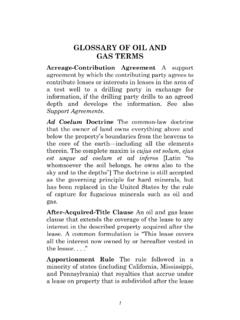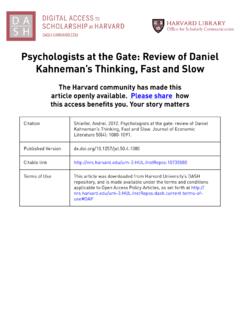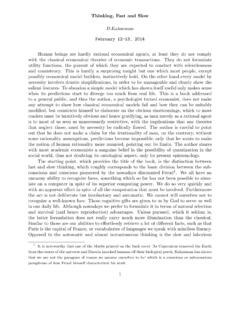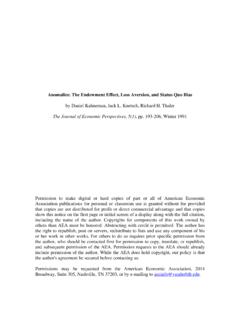Transcription of #24. A Summary of ‘Thinking, Fast and Slow’ by Daniel …
1 thinking , fast and slow by DanielKahneman (Farrar, Straus and Giroux;October 25, 2011)November 13,2012#24. A Summary of thinking , fast and slow by Daniel KahnemanTable of Contents:i. Introduction/SynopsisPART I: AN INTRODUCTION TO thinking , WITH A FOCUS ON SYSTEM 1 Section 1: An Introduction to Thought, fast and Slow1. Thought, fast and SlowSection 2: System 1 Under the Microscope2. Learning by Association and the Priming Effecta. Associationb. The Priming Effect3. Context and Causalitya. Contextb. Causality4. Judging and Evaluating on Limited Evidence: WYSIATI and Substitutiona.
2 WYSIATI b. Substitution5. When System 1 Judges People: Stereotypes, First Impressions, and the Halo Effecta. Stereotypesb. First Impressionsc. The Halo Effect6. The Interaction Between System 1 and System 2 PART II: THE ERRORS OF SYSTEM 17. An Error of Association and Priming: The Anchoring Effect8. The Framing Effect9. File Under WYSIATIa. WYSIATI and Confidenceb. WYSIATI and Estimationsc. The Two Selvesd. WYSIATI and Optimism10. Causal Errors and Statistical Illiteracya. Causal Errorsi. Mistaking Stats for Causesii. Mistaking Luck for Causesb. Statistical Illiteracy11.
3 Loss Aversiona. Avoiding Lossesb. Cutting Our Lossesc. Risk Aversion12. Expert Intuition13. Conclusion i. Introduction/SynopsisThe adage you are what you eat is no doubt literally true, but when it comes to getting at the heart of what we are it iscertainly more accurate to say you are what you think ; for our identity emerges out of the life of the mind, and ourdecisions and actions (including what we eat) is determined by our thoughts. An exploration of how we think thereforecuts to the core of what we are, and offers a clear path to gaining a better understanding of ourselves and why webehave as we do.
4 In addition, while many of us are fairly happy with how our mind works, few of us would say that wecould not afford to improve here at least in some respects; and therefore, an exploration of how we think alsopromises to point the way towards fruitful self-improvement (which stands to help us both in our personal andprofessional lives). While thinking about thinking was traditionally a speculative practice (embarked upon byphilosophers and economists) it has recently received a more empirical treatment through the disciplines ofpsychology and neuroscience. It is from the latter angle that the Nobel Prize winning psychologist Daniel Kahnemanapproaches the subject in his new book thinking , fast and the title would suggest, kahneman breaks down thinking into 2 modes or systems.
5 slow thinking is the system thatwe normally think of as thought in the strictest sense. It is deliberate and conscious, and we naturally feel as thoughwe are in control of it ( kahneman refers to it as system 2). System 2 is in play when we actively consider what wewant to have for dinner tonight, or when we choose what stocks to buy, or when we perform a mathematicalcalculation. System 1, by contrast, is automatic and unconscious, and hums along continuously in the background. Itconstantly surveys the environment, and processes the incoming stimuli with razor 1 is informed by natural drives and instincts but is also capable of learning, which it does by way ofassociation (that is, connecting up novel stimuli with known stimuli according to shared characteristics, contiguity intime and place, or causality).
6 The system is designed to give us an impression of our environment as quickly aspossible, thus allowing us to respond to it immediately, which is especially important in times of danger. In order to doso, system 1 relies on general rules and guidelines (called heuristics). These heuristics are primarily geared to help usin the moment and are tilted towards protecting us from danger, and in this respect they are mostly very useful. Still,mistakes can be made, and the system was specifically designed to work in the environment in which we evolved,which is quite different from our current one, so this adds to its and above this, the impressions that system 1 forms are also fed up to system 2.
7 Indeed, whenever system 1senses something out of the ordinary or dangerous, system 2 is automatically mobilized to help out with the even when system 2 is not mobilized specifically out of danger, it is constantly being fed suggestions by system , while the impressions of system 1 are fairly effective in protecting us from moment to moment, they are muchless effective in long-term planning; and therefore, they are much more problematic here. Of course, system 2 iscapable of overriding the impressions of system 1, and of avoiding the errors. However, as kahneman points out,system 2 is often completely unaware that it is being influenced (and misled) by system 1; and therefore, is notnaturally well-equipped to catch the errors.
8 Much of the book is spent exploring the activities and biases of system 1,in order to make us more aware of how this system works and how it influences (and often misleads) system is only half the battle, though, for while system 2 may be naturally poorly equipped to catch the errors of system 1,it is also often poorly equipped to correct these errors. Indeed, kahneman argues that system 2 is simply not aparagon of rationality (as is often assumed in economics), and could stand to use a good deal of help in this most glaring deficiency of system 2, according to kahneman , is that it is naturally very poor with probabilities andstatistics.
9 Fortunately, system 2 can be trained to improve here, and this is another major concern of the is Daniel kahneman introducing and discussing his book with Charlie Rose:What follows is a full executive Summary of Daniel kahneman s thinking , fast and I: AN INTRODUCTION TO thinking , WITH A FOCUS ON SYSTEM 1 Section 1: An Introduction to Thought, fast and Slow1. Thought, and fast and SlowWe think of ourselves as the executive in control of our minds and bodies. The decision-maker with distinct beliefswho weighs alternative options, deliberates, and comes to choices based on our better judgment which choicesultimately govern our behavior.
10 This kind of thinking is what kahneman refers to as System 2: when we think ofourselves, we identify with System 2, the conscious, reasoning self that has beliefs, makes choices and decides whatto think about and what to do (loc. 402). According to kahneman , though, System 2 is actually much more influencedthan we tend to think by a second mode of thought that the author refers to as System 1 (loc. 402) (the terms System1 and System 2 were originated by the psychologists Keith Stanovich and Richard West [loc. 396]).Unlike System 2, System 1 is automatic and unconscious, and therefore often goes unnoticed.





